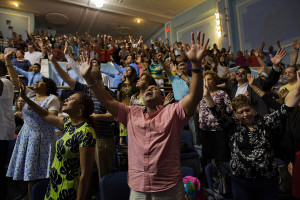Remember back when the American establishment admired missionaries? No you do not, because that was 1901 and you were not born yet.
I say this because I’ve been re-reading Barbara Kingsolver’s The Poisonwood Bible for a faculty/student book club I am in. It’s a clever novel, but I am finding it more annoying than the first time I read it about fifteen years ago.
I’m afraid, then, that a tone of annoyance will probably run through this post. I apologize to all of you for this, except to those former students (this for you, Brian Faehnrich, if you are reading this) who said they enjoyed times when I ranted in class.
(Sigh. I really shouldn’t do that. Rants often reinforce stereotypes, which is the main problem addressed in this post. We humans are a messy lot, aren’t we?)
 Kingsolver’s novel tells the story of a missionary family (parents and four daughters) in the Congo in 1960. The missionary father is strict, stubborn, uncaring, narrow-minded, obtuse, controlling and tragic. The first time I read it, I was willing to let this go as a story about an outlier — every group has their disturbed individuals, after all.
Kingsolver’s novel tells the story of a missionary family (parents and four daughters) in the Congo in 1960. The missionary father is strict, stubborn, uncaring, narrow-minded, obtuse, controlling and tragic. The first time I read it, I was willing to let this go as a story about an outlier — every group has their disturbed individuals, after all.
I was too charitable. This time through, I see the novel as a critique of a patriarchal system that encompasses families, religion and politics. Men dominate these systems in the novel and that creates all sorts of problems for everyone they interact with.
And it is all too simplistic. Patriarchy is a complicated and problematic feature of many societies, but I’d like to leave that aside for now to draw attention to Kingsolver’s understanding of missionaries. She seems to have picked up these perceptions from the American establishment. None of the twenty-eight books that she lists as sources effectively address missionaries or evangelicals, with the exception of a book written by David Livingstone in 1872 and Chinua Achebe’s Things Fall Apart. So it seems Kingsolver is basing her understanding of missionaries on the assumptions of her culture. Granted, I am sure she ran into missionaries and a few evangelicals when she lived in the Congo, but of course, real-life missionaries apparently ran into a few Africans when they lived in the Congo, and that didn’t always guarantee that they understood them well.
As I mentioned, the American establishment admired missionaries in 1901. You could see changes coming in 1901. That was the year that Mark Twain published a number of pieces that accused missionaries of behaving badly. Actually, he depicted them of being hypocritical, narrow-minded imperialists.

Mark Twain: expert on Chinese culture, anthropology, and theology. Or, wait a minute…maybe he was the guy who wrote “The Adventures of Tom Sawyer”
Twain’s writings were controversial at the time, but these kinds of ideas gradually caught on in the American establishment. In 1927, the nationally known pundit, H.L. Mencken, wrote that the Chinese “see that the missionary is not only a most unpleasant theological propagandist, but also that he is the advance agent of all sorts of commercial exploiters, and even of military assassins…..If the missionaries will retire gracefully, shouting polite hosannas, well and good; if they linger, they will be heaved out. Who will blame the Chinese?” By the 1970s, social scientists were using the term “missionary position” to explain how missionaries tried to convince South Pacific Islanders the “proper” position for sexual intercourse. This was, of course, an illustration of how missionaries thoroughly impose their cultural values on others.
Imagine, then, the situation faced by a student that I had taught in the early 1990s when my wife and I served at Rift Valley Academy in Kenya. This student, whose parents were missionaries, had gone off to college at Northwestern University in Evanston, Illinois. During arrival weekend she was involved in one of those mixers that help students get to know one another. A fellow freshman asked her where she went to high school and she told him Kenya. When she explained that her parents were missionaries, he replied, “Oh. Your parents are cultural imperialists.”
Now, this guy was quite bright, if not especially blessed with tactfulness. Northwestern is a prestigious university and it does not accept dull-witted types. But I should point out that this guy was 18 years old and had not yet had a single college class. (Not that his college classes would have changed his thinking on this issue). He hadn’t been to Africa and he did not even know any missionaries. In other words, he didn’t know a hill of beans about missionaries except for a stereotype he had picked up somewhere in American culture.
The same goes for Mark Twain. And H.L. Mencken. And those social scientists in the 1970s. And Barbara Kingsolver.
Let’s start with Twain. Some missionaries in 1901 — the ones Twain was writing about — were behaving badly in China in their reaction to the Boxer Rebellion. They were demanding that the Chinese government pay reparations to missionary agencies in response to rioters who had killed a number of missionaries and destroyed property. And they wanted the militaries of the western imperialist powers to back them up. That is not good. But most missionaries did not respond this way. Hudson Taylor, who led the China Inland Mission, for instance, which suffered more missionaries killed than any other agency, stated that CIM missionaries would not demand anything, but proceed with gentleness and meekness.

H.L. Mencken, champion of the “smart set” in the 1920s. Like Mencken, the “smart set” understood what was going on with missionaries in places like Africa and China because they were, you know, “smart.”
H.L. Mencken? He regularly wrote things like, “Religion is fundamentally opposed to everything I hold in veneration — courage, clear thinking, honesty, fairness, and, above all, love of the truth.” Hey, that’s clever, H.L. It’s also a fine example of a statement that does not give careful consideration to clear thinking, honesty, fairness and the love of truth. Mencken regularly reached for ammunition rather than illumination when it came to areas of religious faith.
Those social scientists in the 1970s? Recent research has shown that the “missionary position” story is an academic myth. There is not a shred of evidence that any missionary anywhere ever said or did anything like this. We can, however, trace the story to speculation by social scientists in the 1940s.
Twain, Mencken, the social scientists and Kingsolver are not the causes of missionary stereotypes. Due to twentieth-century cultural, theological, and social forces (hey, that all sounds exciting and clear, doesn’t it?) the stereotypes would have emerged from others anyway. And they did, in fact. The point is that missionary stereotypes permeated the twentieth-century American establishment. As I hope to show in the next post, there are important reasons why these stereotypes need to go.
Oh, and my former student at that freshmen mixer at Northwestern? She asked the guy what he knew about the world and he explained that he had a good awareness of the world. His parents actively supported international organizations that promoted family planning around the world.
“Why then,” she said, “are my parents considered cultural imperialists and yours are not?” He did not have a good answer.











